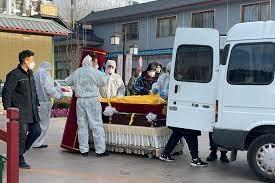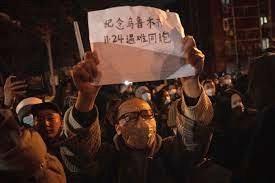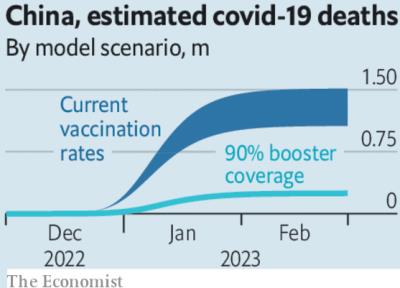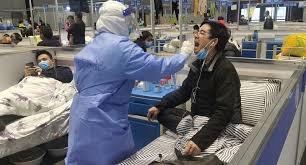Both international public health authorities and economists are closely observing the response to the abrupt change in official policy regarding control of COVID in China. Official statistics, always questionable, now admit to over 100,000 fatalities since late December. Social media in China characterize the escalating incidence rate as a haixiao or tsunami. International epidemiologists suggest that as many as 40 million new cases are occurring daily. In high-density mega-cities, such as Beijing and Shanghai, as many as 70 percent of the population may already have been exposed.

The Government of China describes the abrupt change in policy from zero COVID to laissez faire (or “let it rip”) as “optimization of prevention and control measures”. It is evident that China wasted three years in an attempt at containment requiring shutdowns. The Government failed to prepare for eventual restoration to pre-COVID social and economic activity by immunizing the population and preparing for an upsurge in hospitalization and ICU admissions.
Airfinity, a research company based in London, forecast fatalities at 10,000 per day, peaking at 25,000 after the Lunar New Year on January 22nd. The Economist predicted that as many as 1.5 million may die from COVID in coming months. The real effect of allowing free movement among a population that is inadequately immunized will only become apparent after return of urban residents to their traditional homes in far-flung provinces following the annual three-week migration.

The burden of COVID will fall disproportionately on the elderly who, unlike their counterparts in Europe and North America, have resisted vaccination even using the imperfect, inactivated domestic vaccines. These are based on obsolete technology and include antigen from the Wuhan 2019 strain. The vaccines manufactured in China require three doses and offer limited immunity against current sub-variants of Omicron strain of SARS-CoV-2 in circulation. Irrespective of Government statistics that are manipulated, the incidence rate of COVID may be judged from demands for cremation that far exceed capacity and a concurrent black market for Paxlovid.
The justification for the Government decision to lift all COVID precautions without an appropriate transition period, is questioned. In the first instance President Xi Jinpeng considered it necessary to keep the lid on the pot until he was confirmed for a third term at the 20th National Congress (Ershi Da) during October 2022. Unprecedented street demonstrations coupled with an obvious decline in exports and plummeting GDP were important factors leading to the decision.
Despite abandoning restrictions, daily activities and hence, the economy have not returned to pre-COVID activity. The surge in cases has sharply restricted the availability of workers in some provinces with Guangdong, Shandong, and Jiansgu impacted by absenteeism that ranges from 25 to 50 percent of workers at present. Despite accumulated savings during the 3-year shutdown, consumers are reticent to venture into shopping areas and restaurants, although the young have returned to bars and night-life and entertainment.

It is understood that Foxcon, a major assembler of electronics and source of export volume, warned the Government that lockdowns were seriously impacting the credibility of China as a reliable supplier. This is evidenced by importers and companies in North America and Europe shifting production from China to plants in Viet Nam and India especially since the onset of COVID.
During the past five years and with intensification during COVID, President Xi has waged war on the private sector. Charges of corruption and fraud whether justified or not have been levied against property developers and entrepreneurs representing the new billionaires in a nation only recently freed from the shackles of doctrinaire communism and the inflexibility of Chairman Mao. Lingling Wei, correspondent for the Washington Post, based in Beijing, recently described the apparent changes in policy with regard to the private sector. Speaking with Fareed Zakaria on the CNN program GPS on Sunday, January 15th, she stated that the Government now recognizes that growth in the economy will only be achieved through the private sector. The traditional playbook of government spending on infrastructure projects to boost the economy will probably not be effective in restoring GDP and entrepreneurs including Jack Ma are now undergoing rehabilitation.
There will be little if any increase in demand by China for U. S. agricultural products over the remainder of the current marketing year ending in September. Corn exports, predominantly to China, are down by half over the corresponding period in the 2021-2022 year. Soybean exports are proceeding at a more favorable rate, down six percent for market year 2022-2023. Recent weekly orders for commodities by China have been, at best, lackluster. Exports of broiler products to China our best customer by value will, in all probability, continue at existing levels. For the first eleven months of 2022, exports of all broiler products to China amounted to 583,425 metric tons valued at $1,024 million, 33 percent higher than in 2021. Of the volume shipped during the first ten months of 2022, feet accounted for 79 percent of volume with only 16 percent represented by legs and leg quarters, the principal export commodity by the U.S. broiler industry.

In the intermediate term, China will achieve a measure of control over COVID with factory production restored and supply chains strengthened. It is possible that during late 2023, congestion may reoccur in U. S. West Coast ports, although Gulf and East Coast ports have been expanded and equipped to accommodate imports from China and other Asian nations.
From a public health perspective, infection of a large, susceptible population with current strains of COVID has the potential to produce new variants that may demonstrate either higher infectivity, pathogenicity or both. This has implications for the entire world population. Attempting to confine variants to China by imposing travel restrictions is essentially shutting the stable door after the horse has bolted. We can only hope that WHO has sufficient leverage with more receptive elements within the public health system of China to release reliable statistics and above all the molecular characterization of variants. In the interim, genetic sequencing of isolates derived from aircraft wastewater can provide some indication of variants circulating in Asia and other continents.
We can but hope that China can control COVID, applying effective mRNA vaccines that can be modified in the short term in response to emerging variants. Increasing purchasing power among consumers will maintain demand for broiler feet, soybeans and corn, although the U. S. will compete with Brazil and Argentina for many commodities.